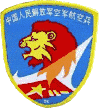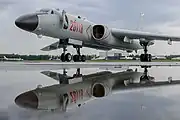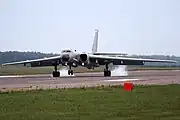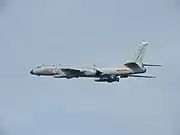| 10th Bomber Division | |
|---|---|
| 空军航空兵第十师 | |
 An intercepted H-6K of the 28th Reg, 10th Div | |
| Active | 17 January 1951–Present |
| Country | |
| Allegiance | |
| Branch | |
| Role | Bomber |
| Part of | Eastern Theater Command Air Force |
| Garrison/HQ | Anqing Air Base, Luhe Air Base |
| Nickname(s) | 10th Bomber Division, Model Bomber Group, Unit 94810 |
| Insignia | |
| Sleeve insignia of the 10th Bomber Division |  |
| Aircraft flown | |
| Bomber | Xian H-6K, H-6M |
The 10th Bomber Division or 10th Air Division (10th AD, Chinese: 空军航空兵第十师; pinyin: Kōngjūn Hángkōngbīng dì Shí Shī, Unit 94810) of the People's Liberation Army Air Force (PLAAF) is an air formation of the People's Republic of China (PRC). The 10th Bomber Division has been accorded the honorary titles of "Model Bomber Group" (模范轰炸机大队) and "Red Banner Division" (红旗师) and is the PLAAF's unit of choice to send to international skills competitions.[1][2]
As one of only three bomber divisions of the PLAAF and the only bomber division assigned to the Eastern Theater Command Air Force, the 10th Bomber Division is almost certainly responsible for providing strategic bombing support capabilities to a potential conflict in the East China Sea including Korea, Japan, or, principally, one involving Taiwan.[1][3]
History
The 10th Bomber Division was established on 17 January 1951 in Nanjing, Jiangsu Province as only the second bomber unit in the People's Republic of China following the creation of the 8th Bomber Division less than two months before. Like the 8th Bomber Division, the 10th drew its initial manning from the PLAAF's first air unit, the 4th Composite Air Brigade, which was also stationed in Nanjing.[1] Originally consisting of the 28th, 29th, and 30th Bomber Regiments operating Soviet-gifted Tupolev Tu-2 bombers, the newly formed 8th Bomber Division was moved to Liaoyang in Liaoning Province to support the People's Volunteer Army against United Nations forces in the Korean War.[1] During the struggle for the island of Taehwa-do, the 8th Bomber Division bombed during daylight hours and the 10th at night.[4] The division was later stationed in Qiqihar, Heilongjiang Province and, in September 1956, moved again to Tangshan, Hebei Province where it would join the Beijing Military Region Air Force (MRAF). Expanding its role to include electronic reconnaissance and electronic warfare, the 28th Bomber Regiment of the 10th Bomber Division received its first series of Illyushin Il-28 bombers in 1957.[1]
In the autumn of 1968, the PLAAF swapped the garrisons of the 8th and 10th Bomber Divisions implementing Lin Biao's dictate that troops should not live in one place for too long while wary of the involvement of the Nanjing Military Region Air Force's participation in the factional struggles of Mao's Cultural Revolution.[4] Later, the 28th and 29th Bomber Regiments of the division began receiving H-6 bombers (a variant of the Soviet Tupolev Tu-16). Shortly after, on 18 December 1968, the 10th Bomber Division's Deputy Commander Li Zhiguo reportedly experienced a cabin short circuit, setting the aircraft ablaze. Although the radioman Ma Shaocheng and navigator Li Qianyuan safely ejected and parachuted to the ground, Li died onboard the crashed bomber.[4] Relocated again to Huaining County in Anhui Province, the 10th Bomber Division engaged in tests bombing ice floes on the Yellow (Huang He) River and a number of nuclear tests using the Chinese built Harbin H-5 (variant of the Il-28s) during the early 1970s.[1][5]
The 30th Bomber Regiment, which had operated the electronic reconnaissance and electronic warfare Il-28s did not receive the new H-6 bombers, instead it was drawn to establish the 142nd Bomber Regiment of the 48th Bomber Division, a now-defunct bomber unit established in August 1970 in Fuyang, Hunan Province. A part of the Guangzhou Military Region Air Force, the 142nd Bomber Regiment was abolished in 1985 and the 48th Bomber Division in 1992. Aircraft and personnel of the former 142nd Bomber Regiment (originally the 30th Bomber Regiment of the 10th Bomber Division) became an independent electronic warfare regiment where it remained until 2003 when the regiment was equipped with specialized variants of Y-8 transport aircraft and reinstated as the 30th Bomber Regiment under the 10th Bomber Division. Adding to the regiment's tumultuous lineage, the 30th Bomber Regiment was abolished in 2012 until, in 2017, it had been re-established and given H-6M bombers.[1]
In the 2016 restructure of the People's Liberation Army, the Nanjing Military Region (under which 10th Bomber Division was hitherto assigned) became the Eastern Theater Command Air Force.[1][6]
Activities
On 1 October 2019, the first hypersonic unmanned aerial vehicle (UAV), the WZ-8 (Chinese: 无侦-8; pinyin: Wú zhēn-bā; lit. 'unmanned recon-8') was unveiled to the public towed at a military parade in Beijing. Although the serial numbers on the WZ-8 airframes were covered for the parade (and covered again at the 2021 Zhuhai Air Show), the state-run, PLA-focused news outlet CCTV-7 published footage of the towed-UAVs during 2019 parade rehearsals with serial numbers unredacted. The two serial numbers, 21311 and 21312, are within the serial range for the 10th Bomber Division's 30th Bomber Regiment stationed at Luhe Air Base just north of Nanjing City, Jiangsu Province.[1][7] Images showing suspension lugs atop the aircraft's dorsal spine further suggest the WZ-8 UAV is to be air-launched from underneath an H-6 bomber raising confidence in the UAV's potential assignment to the bomber unit.[7][8][9]
In 2021, the 10th Bomber Division began to receive H-6Js, the upgraded naval variant of the H-6K with improved payload capacities and electronic warfare capabilities. It is unclear which regiments may have received the new H-6Js.[2]
On 19 September 2020, in response to U.S. Undersecretary of State Keith Krach's visit to Taipei, the official People's Liberation Army Air Force Sina Weibo account posted a video titled "The God of War H-6K Goes on the Attack!" which showed a movie-trailer-style simulated strike on Anderson Air Force Base in Guam and used clips copied from a number of American movies including The Hurt Locker, The Rock, and Transformers: Revenge of the Fallen.[10][11] The two H-6s prominently featured in the video bear the tail numbers 20012 and 20013 and are from the 28th Bomber Regiment of the 10th Bomber Division.[12] Online mockery of the video, highlighting the crudely copied footage, led to the PLAAF deleting the post three days later.[10]
For years, H-6K bombers of the 10th Bomber Division's 28th Bomber Regiment have routinely joined other military aircraft of the PLAAF (including J-11s, J-16s, Y-8s, Su-30s, KJ-500s, and various UAVs)[13] in unannounced incursions into the Taiwanese and sometimes Japanese Air Defense Identification Zones (ADIZ) carrying a variety of payload munitions.[14][15][16] These incursions have gained international attention, especially in annual joint patrols between bombers of the Chinese 28th Bomber Regiment and Russian Tu-95MS strategic bombers including during meetings of the Quad.[16][17][18]
On 30 November 2022, two H-6 bombers of the 10th Bomber Division's 28th Bomber Regiment (tail numbers 20213 and 20214) joined four Russian Tu-95 strategic bombers in an eight-hour joint patrol through the Tsushima Strait and into the Sea of Japan.[19][20] The joint bomber patrol, met by scrambled fighters from Korea and Japan, was escorted by two Russian Sukhoi Su-35S fighter jets and later by two Russian UAVs.[20][21] The flights, which entered the Korean Air Defense Identification Zone (not recognized by either Beijing or Moscow),[21] garnered significant press attention featuring videos showing the first instance of Russian bombers landing in China and the two Chinese bombers of the 28th Bomber Regiment landing at Vladivostok International Airport in eastern Russia.[21][22][23][24]
Organization
Today, the 10th Bomber Division commands three subordinate bomber regiments, the 28th, 29th, and 30th Bomber Regiments in Anhui and Jiangsu Provinces. The division headquarters comprises a Staff Department (参谋部), Political Work Department (政治工作部), and Support Department (保障部), each having subordinate second and potentially third-level departments below them. A number of principal leaders in division headquarters also form the division's Party Standing Committee (党委常委) which includes the division commander and at least two of his deputy commanders, the political commissar and at least one of his deputy political commissars, the secretary of the Discipline Inspection Committee, the division chief of staff (who directs the Staff Department), director of the Political Work Department, as well as the director of the Support Department and his political commissar.[25]
Each of the 10th Bomber Division's three bomber regiments are led by a regimental commander, regimental political commissar, two deputy commanders, and a deputy political commissar. Within regimental headquarters are two departments, the Staff Department (previously known as the Headquarters Department) headed by the regimental chief of staff and a Political Work Division (previously the Political Division) led by a director. Although these regiments have maintenance groups, they do not have organic logistics, equipment, or support departments.[26]
The 10th Bomber Division operates a mix of H-6 variants: the latest variant, the H-6K with new engines,[27] flight deck, intakes, and radome;[28] the H-6H designed to carry land-attack cruise missile (LACM);[29] and the H-6M with four under-wing cruise missile hardpoints.[30][25] Bombers of the 8th Bomber Division can be identified by tail numbers (painted on the fuselage aft of the cockpit and forward of the intake) and all have number '1' as the penultimate digit. The range of tail numbers assigned to each unit are not indicative of the actual quantity of aircraft.[31][32] The division's military unit cover designator (MUCD) is Unit 94810.[33][34]
- 28th Bomber Regiment at Anqing Air Base operates H-6K bombers, tail numbers 20011–20419[25]
- 29th Bomber Regiment at Luhe Air Base operates H-6H bombers, tail numbers 20511–20919[25]
- 30th Bomber Regiment at Luhe Air Base operates H-6M bombers, tail numbers 21011–21419[25]
The three bomber regiments of the 10th Bomber Division oversee two to three flight groups (飞行大队). In most bomber units, some flight groups are operational with one set aside for training new pilots. These subordinate flight groups fly around eight to ten bombers and are led by a commander, political director, two deputy commanders, and a deputy political director. These flight groups, the PLAAF's basic operational air unit, each lead two to three flight squadrons (飞行中队) flying two to five bombers per and are led by a commander, political instructor, and one to two deputy commanders.[35]
Gallery
 An H-6K of the 28th AR on display at Dyagilevo for Aviadarts 2018
An H-6K of the 28th AR on display at Dyagilevo for Aviadarts 2018 An H-6A formerly used by the 29th AR with tail and rear guns
An H-6A formerly used by the 29th AR with tail and rear guns An H-6K of the 28th AR lands at Dyagilevo for 2018 Aviadarts
An H-6K of the 28th AR lands at Dyagilevo for 2018 Aviadarts Intercepted H-6K bomber of the 28th AR carrying ordnance
Intercepted H-6K bomber of the 28th AR carrying ordnance
See also
References
- 1 2 3 4 5 6 7 8 9 Allen, Kenneth W. (2 May 2022). "PLA Air Force Bomber Force Organization" (PDF). China Aerospace Studies Institute. Air University, Montgomery, Alabama.
- 1 2 "官方首次证实! 东部战区空军列装新型战略轰炸机" [Officially confirmed for the first time! The Air Force of the Eastern Theater Command has installed a new type of strategic bomber] (in Chinese). 23 February 2021.
- ↑ Army Techniques Publication (ATP) 7-100.3: Chinese Tactics. Washington D.C.: Headquarters, Department of the Army (United States). 2021. p. 35. ISBN 9798457607118.
- 1 2 3 "《八师轶事》之112" [Anecdotes of the 8th Division, Chapter 112]. Baidu Tieba (in Chinese). 10 August 2018.
- ↑ "一二〇,空中 取样 (H试验空投" [Aerial Sampling of the H Bomb Test Airdrops]. Baidu Tieba (in Chinese). 16 February 2020.
- ↑ "详解五大战区范围:战区陆军司令部独立驻扎". Sina Corp. 11 February 2016. Archived from the original on 26 December 2017. Retrieved 25 December 2017.
- 1 2 Rupprecht, Andreas (4 October 2019). "Images suggest WZ-8 UAV in service with China's Eastern Theatre Command". Jane's Information Group.
- ↑ "AVIC WZ-8". Military Factory. 22 June 2022.
- ↑ Yeo, Mike (30 September 2021). "Chinese airshow offers glimpse at military's new drones". Defense News.
- 1 2 Lendon, Brad (22 September 2020). "Chinese air force propaganda video appears to use Hollywood movie clips". CNN.
- ↑ Mizokami, Kyle (22 September 2020). "China Made This Fake Video of Bombers Attacking U.S. Targets. It's Bonkers". Popular Mechanics.
- ↑ "China air force video appears to show simulated attack on U.S. base on Guam". Reuters. 21 September 2020.
- ↑ "China makes second largest Taiwan defence zone incursion this year". France24. Agence France-Presse. 31 May 2022.
- ↑ Ministry of National Defense, Republic of China [@MoNDefense] (18 September 2020). "Sep. 18, two H-6 bombers, eight J-16 fighters, four J-10 fighters and four J-11 fighters crossed the midline of the #TaiwanStrait and entered #Taiwan's southwest ADIZ. #ROCAF scrambled fighters, and deployed air defense missile system to monitor the activities" (Tweet) – via Twitter.
- ↑ Ryan Chan 陳家翹 [@ryankakiuchan] (23 June 2022). "Three China PLA H-6 bombers transit Miyako Strait from East China Sea to Pacific Ocean back and forth on June 23. Two of them each carrying four YJ-12 supersonic anti-ship missiles" (Tweet) – via Twitter.
- 1 2 Chris Cavas [@CavasShips] (30 November 2021). "Russian and Chinese aircraft photographed by the Japanese Self-Defense Force near Japan on 19 Nov. Two Chinese H-6KG bombers of the 10th Bomber Division, 28th Air Regiment joined by two Russian Air Force Tu-95MS strategic bombers" (Tweet) – via Twitter.
- ↑ Woody, Christopher (24 May 2022). "As Biden meets with Asian allies, Russia and China display their own ties with a 'more provocative' bomber flight". Business Insider.
- ↑ "China, Russia jets conducted patrol as Quad leaders met in Tokyo". Al Jazeera. 24 May 2022.
- ↑ "中国軍機及びロシア軍機の動向について" [Trends of Chinese and Russian Military Aircraft] (PDF). Ministry of Defense (Japan) (in Japanese). 30 November 2022. pp. 3–4.
- 1 2 Mahadzir, Dzirhan (30 November 2022). "Japanese, Korean Fighters Scrambled in Response to Joint Russia-China Bomber Patrol". United States Naval Institute.
- 1 2 3 Shin, Hyonhee (30 November 2022). "South Korea scrambles jets as China, Russia warplanes enter air defence zone". Reuters.
- ↑ Moore, Mark (30 November 2022). "South Korea scrambles jets after Russia, China warplane flyover". New York Post.
- ↑ Tu-95 bomber landing in China, the first foreign bomber visit to China in decades. 30 November 2022.
- ↑ Amelia Smith [@ameliairheart] (2 December 2022). "Imagery from @planet shows PLAAF H-6K bombers 20213 and 20214 at Vladivostok International Airport in eastern Russia. They landed there on November 30th as part of a joint Russia-China exercise that saw Russian aircraft land in China and Chinese aircraft land in Russia. 1/3" (Tweet) – via Twitter.
- 1 2 3 4 5 Allen, Kenneth W. (2 May 2022). "PLA Air Force Bomber Force Organization" (PDF). China Aerospace Studies Institute. Air University, Montgomery, Alabama.
- ↑ Allen, Kenneth W. (2 May 2022). "PLA Air Force Bomber Force Organization" (PDF). China Aerospace Studies Institute. Air University, Montgomery, Alabama.
- ↑ Fisher, Richard (27 May 2015). "ANALYSIS: Can China break the military aircraft engine bottleneck?". FlightGlobal. Retrieved 2 November 2021.
- ↑ "H-6K Cruise Missile Bomber PLAAF". AirForceWorld.com. Archived from the original on 3 March 2011. Retrieved 5 April 2011.
- ↑ "Reconnaissance & Special-Mission Tu-16s / Xian H-6". Air Vector. Archived from the original on 22 April 2017. Retrieved 7 April 2015.
- ↑ Isby, David C. (29 September 2006). "Chinese H-6 bomber carries 'improved missiles'". Jane's Missiles and Rockets. Jane's Information Group. Archived from the original on 30 November 2006. Retrieved 16 January 2007.
- ↑ Allen, Kenneth W. (2 May 2022). "PLA Air Force Bomber Force Organization" (PDF). China Aerospace Studies Institute. Air University, Montgomery, Alabama.
- ↑ officer), Kenneth W. Allen (Retired Air Force; Garafola, Cristina L. (2021). 70 Years of the PLA Air Force. China Aerospace Studies Institute. ISBN 979-8-7248-6088-8.
- ↑ "共军空军部队情况" [The Situation of the Communist Air Force]. Banned Books Network (in Chinese).
- ↑ Ming, Chen; Shuangxi, Wang (12 September 2013). "光荣的"飞行安全红旗师"——记中国人民解放军空军94810部队史" [The Glorious "Flight Safety Red Banner Division" — A History of Unit 94810 of the Air Force of the Chinese People's Liberation Army]. Military History Studies (军事历史研究) (in Chinese). 27 (1): 172–180.
- ↑ Allen, Kenneth W. (2 May 2022). "PLA Air Force Bomber Force Organization" (PDF). China Aerospace Studies Institute. Air University, Montgomery, Alabama.
